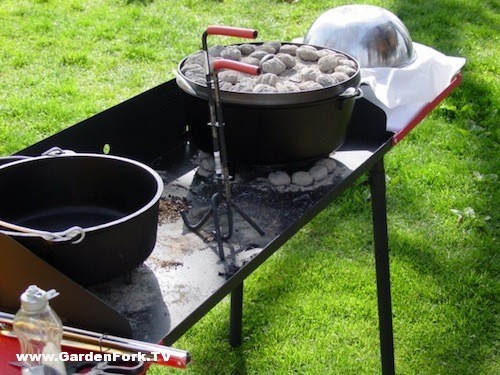This is the third of a series of articles about how to cook in a dutch oven, dutch oven recipes, and how to season cast iron and dutch ovens by Gary House, of Cooking-Outdoors.com. A big thank-you to Gary for contributing this.

The good news is that almost all new Dutch ovens come pre-seasoned direct from the factory. Today’s seasoning process at the factory is so good; you can use your new Dutch oven right out of the box (after washing) without going through the initial seasoning process. New Dutch ovens will still require continuous seasoning to build up the layers of protection.
Seasoning is the process of applying thin layers of grease or oil and baking until absorbed into the cast iron. This continuous process builds up layers of “carbonized” oils, protecting the surface from rust and giving you that desired non-stick coal black patina coating.
Vegetable oil, olive oil, bacon grease, Crisco, lard and premade seasonings are commonly used to season cast iron. I cannot tell you what one is best for you and everyone has their special grease or oil that they prefer; I will recommend you try grease instead of oil, as it is easier to see when you apply too much allowing you to remove the excess. Personally, I use Crisco these days and it works very well for me.
If you do have an un-seasoned Dutch oven or skillet and want to season it here are 8 simple steps to make that process easy:
• Wash with soap and water.
• Dry completely with heat, a towel will not remove enough moisture. Place cast iron in oven for a few minutes or in the sun if hot out until it is too hot to handle with your bare hands but easy to handle with heat pads. (Cast iron absorbs grease and oils best when warm so apply your seasoning to pre-heated cast iron that is warm to the touch, no need to burn yourself. Pre-heating opens up the cast iron pores to allow the seasoning to be absorbed.)
• Before applying seasoning, check for rust. Now is the time to remove it.
• Lightly grease inside and out, you do not want the oil to pool or build up anywhere while you are seasoning your oven. Lightly means enough to change the color of the cast iron; do not apply a heavy coating that feels sticky to the touch.
• Place your Dutch oven upside down with the lid laying flat on the grate into a BBQ that can maintain 375° F consistently for one hour. If you use your oven in the house you could get a lot of smoke in the kitchen, consider yourself warned.
• Bake for 1 hour at 375° F
• Turn heat off, open lid and let cool.
• Repeat two more times for best results.
Your Dutch oven is ready to use!
For bests result, apply a light coat of seasoning to your Dutch oven after every use. This builds up the layers of carbonized grease every time you do this, giving you layers of protection and non-stick surfacing.
There may come a time when you need to re-season your cast iron; perhaps it is getting a little rust, some bubbles have formed or the finish is chipping off. All caused from improper seasoning or care, but easily fixed.
• Place your Dutch oven or cast iron skillet in a self-cleaning oven.
• Turn and lock oven in the self-cleaning cycle.
• Run until cleaning cycle is complete. Your Dutch oven will be a light grey color when done.
• Let cool for a couple of hours
• Repeat steps 1 through 8 above.
I will leave you with my 6 Golden rules for storing your Dutch oven
Rule #1
Never put away your Dutch oven dirty.
Rule #2
Never put away your Dutch oven wet.
Rule #3
Put a light coating of seasoning on your Dutch oven while it is warm from cleaning.
Rule #4
Air circulation prevents a rancid Dutch oven; store with the lid off or ajar.
Rule #5
Store your Dutch ovens in the house where the humidity is balanced.
Rule #6
Rotate your Dutch ovens when selecting one for a meal. The one on the bottom in the corner is all dusty is going bad on you!
Next time we will discuss temperature control when cooking and I will have an easy bread recipe for you!
Part Three of our Dutch Oven Cooking Series by Gary House, creator of www.Cooking-Outdoors.com; an excellent source for all things about outdoor cooking, including Grill & Smoker reviews, recipes, and videos.
Gary is also the host of a new DVD, Taking Your Dutch Oven To The Max, using the dutch oven to smoke, grill, and even make ice cream.
Listen to Gary on this episode of GardenFork Radio talk about how to season cast iron, how to use a dutch oven, and dutch oven recipes.











 Part One of a Dutch Oven Cooking Series by Gary House, creator of www.Cooking-Outdoors.com; an excellent source for all things about outdoor cooking, including Grill & Smoker reviews, recipes, and videos.
Part One of a Dutch Oven Cooking Series by Gary House, creator of www.Cooking-Outdoors.com; an excellent source for all things about outdoor cooking, including Grill & Smoker reviews, recipes, and videos.